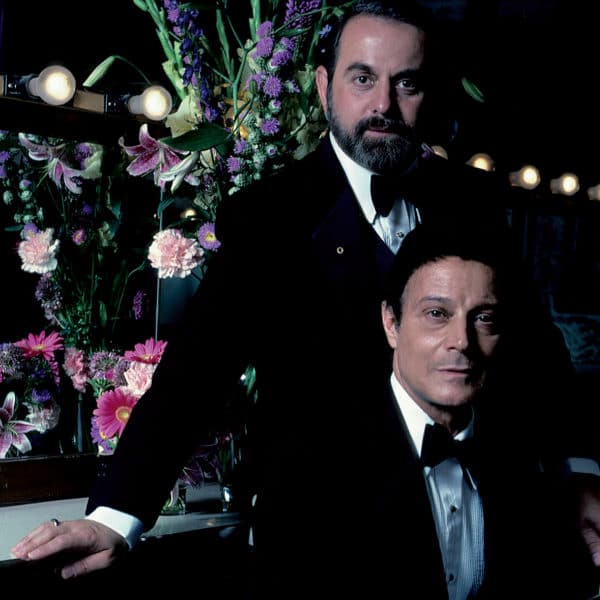History of Arpino and Joffrey
“For the choreographer, the last part of the 20th century is a wonderful and exciting age to live in. Great possibilities lie ahead… Our best course is to recognize fully the nature of the revolution that has taken place in dance during this century. A promising future has been laid before us, but first we must take stock of our inheritance.”
Robert Joffrey and Gerald Arpino opened the Joffrey Ballet School on Sixth Avenue in New York City’s Greenwich Village in 1953. Within a year, while still dancing and teaching, these two young, ambitious men debuted the Robert Joffrey Ballet Concert with performances at the 92nd St. YMHA. In 1956 six dancers, including Arpino, set off in a borrowed station wagon on the inaugural tour of the Robert Joffrey Theatre Dancers, dancing four works choreographed by Joffrey. The company performed twenty-three one-night stands in eleven states, while Joffrey stayed in New York and continued teaching to keep the school in operation and to generate income for the company.
Joffrey and Arpino envisioned their company as a radical departure from other ballet companies of the time. Comprised of a small group of youthful, athletic, all-American dancers trained by Joffrey, they performed an eclectic repertory and pioneered a new model for ballet programming, with an initial emphasis on work by American choreographers and composers. Joffrey soon began commissioning works from modern and postmodern choreographers such as Alvin Ailey, Anna Sokolow, and Twyla Tharp, a bold and unprecedented strategy for a ballet company. The repertory quickly expanded to include both classical and contemporary, cutting-edge works, as well as important revivals from the early 20th century, creating a unique profile that would set the company apart.
Within ten years, the Robert Joffrey Ballet had performed at the White House for President John F. Kennedy and had traveled on State Department-sponsored tours of the Middle East, India, and the Soviet Union. In Moscow they danced thirteen sold-out performances to critical acclaim, with closing-night ovations lasting nearly as long as some of the ballets. In 1966, after a brief association with Rebekah Harkness, the company replaced the New York City Ballet as the resident company of City Center Theater and was renamed the City Center Joffrey Ballet. Arpino was appointed resident choreographer, and over the next forty years created nearly fifty ballets for the repertory, including signature works such as Viva Vivaldi (1965), Trinity (1970), and Light Rain (1981). In 1967 Joffrey choreographed Astarte, the first multi-media rock ballet, set to a specially commissioned score. The impact on the dance world was enormous, and led to Astarte being featured on the covers of both Time and Lifemagazines.
As a complement to this avant-garde approach, Joffrey began mining the rich history of dance by presenting revivals of important 20th-century ballets, such as Kurt Jooss’ The Green Table (1932), and later Leonide Massine’s Parade (1917), as well as the reconstruction of Vaslav Nijinsky’s lost masterpiece Le Sacre du Printemps (1913). In addition, Joffrey’s “all-star, no-star” system departed from the typical hierarchy of a traditional ballet company, promoting a sense of unity while showcasing each dancer’s talent and individuality in an artful reflection of democratic American values. In a relatively short time, the Joffrey Ballet secured its place as an important and celebrated American ballet company with an impressive international reputation.
Throughout the 1970’s and 80’s the Joffrey Ballet became the largest repository of works by Frederick Ashton, outside of the Royal Ballet in England, and expanded its notable repertory by presenting the works of important European choreographers such as John Cranko, Jiří Kylián, and Frankfurt-based American William Forsythe, a former Joffrey dancer. Joffrey also continued to give young gifted choreographers opportunities, and was a formative influence on many future artistic directors who began as dancers in his company.
In 1987, Joffrey conceived and Arpino choreographed their final collaboration, The Nutcracker. This was Joffrey’s way of ensuring that the company would continue after his imminent death. The following year, after the passing of Robert Joffrey, Arpino became artistic director. In 1995, he boldly orchestrated a pivotal move for the company, relocating it from New York City to Chicago, thus securing its future. Arpino was honored as Director Emeritus in 2007, setting the stage for Ashley Wheater to step in as the third artistic director of The Joffrey Ballet. Today, Wheater, along with chief executive officer Greg Cameron, continues to carry forward the enduring legacies of both Joffrey and Arpino.

